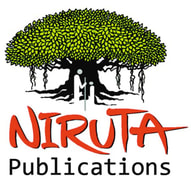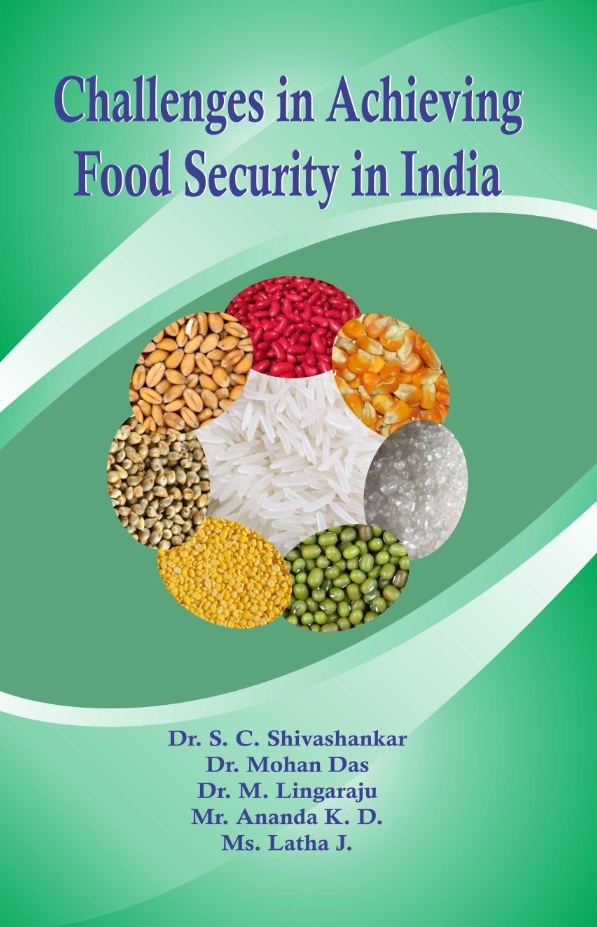- General Books
- >
- Challenges in Achieving Food Security in India
Challenges in Achieving Food Security in India
SKU:
$0.00
Unavailable
per item
Contents
Part I: Concept of Food Security
1. Food Security in India: Issues and Challenges
Dr. S.C. Shivashankar and P.T. Srinivas Naik
2. Food Security in India: Issues, Dimensions and Policies
Dr. T.C. Chandrashekar
3. Food Security in India: Issues and Suggestions for
Effective Implementation and Impact
Prof. Sundaravalli and Dr. Sampangi Ramaiah
Part II: NFSA 2013
1. Efficiency and Accountability in Establishing Food
Security in India: Issues and Suggestions
C .M. Ibrahim .
2. Food Security Bill and Its Impact: A Critical Analysis
Prof.D. Tharamathi
3. Impact of National Food Security Act-2013: A Critical
Reflection
Mala M.
4. Food Security in India under WTO Regime
Vinod Kumar S.
5. Food Security - Economic Implications of NFSB - 2013
G. Srinath Raj and Latha J.
6. Impact of Food Security Act, 2013 on Children in India
Sheik Hyder Ali D.S.
Part Ill: Food Security and Nutrition
1. Nutrition Security in India-Challenges
Mangala T.
2. Food Security-A Remedy for Malnutrition
Veena Anand Karagudari
3. Malnutrition in Rural Kamataka: A Sociological Analysis
Dr. Raghavendra Gudagunti,
Dr. C. Laxminarayan Reddy
Part IV: Poverty Eradication
1. Poverty Eradication and Food Security
Dr. C.L. Gayathri Devi and Pushpa.N
2. Food Security and Poverty Elimination in India
Dr. Pushpa.B and Dr. Renukamba.P.C
Part V: Support Programmes for Food Security
1. Public Distribution System in Karnataka-An Empirical
Study on Anna Bhagya Scheme
Dr. Suresha K.P
2. Food Security through the Integrated Child Development
Services (ICDS) Programme
M.C. Lakshmaiah
3. A Scenario of Food Security through Public Distribution
System in India
Dr. B.A. Venkateshalu and D.C. Kurnal
Part VI: Agriculture
1. Effects of Climate Change on Indian Agriculture and Food
Security
Dr. Nagaveni.S
2. Agriculture and Food Security in Tumkur District-An
Overview
Dr. K.R.Prasanna Kumar
3. Food Security and Organic Agriculture
Kempe Gowda. P
Part VII: Conclusions
1. Towards Achieving Food Security: Remedies for
Constraints
Manjula S. Badage
2. Challenges in Achieving Food Security in India
Dr. B.A. Venkateshalu
Over half the world's underweight children live in India, Bangladesh and Pakistan, says a UNICEF report on the global progress on children's issues. About 5.6 million children worldwide die every year for lack of adequate nutrients. Today, 27 per cent of children in developing countries are underweight that's around 146 million children.
In India, over the past 15 years the debate about food, under a rights-based perspective, has become increasingly complex. Earlier concerns about famines, emergency relief and technology-driven green revolutions have given way to discussions on the state's failure to deliver Public Distribution Programmes, the discriminatory biases these programmes perpetuate, legal entitlements to land use and ownership by men and women farmers, climate change, domestic and international price volatility and the role of non-governmental and social actors ~ from the media to NGOs, farmer's networks and social movements. In other words, the debate has shifted from starvation and subsistence to dignity and justice. Hence, the passage of the Food Securities Act.
As passed by the Parliament, Government has notified the National Food Security Act, 2013 on 10th September, 2013 with the objective to provide for food and nutritional security in human life cycle approach, by ensuring access to adequate quantity of quality food at affordable prices to people to live a life with dignity. The Act provides for coverage of up to 75 per cent of the rural population and up to 50 per cent of the urban population for receiving subsidized foodgrains under Targeted Public Distribution System (TPDS), thus covering about two-thirds of the population. The eligible persons will be entitled to receive 5 Kgs of per person per month at subsidized prices of Rs. 312/1 per Kg for rice!wheat! coarse grains. The existing Antyodaya Anna Yojana (AAY) households, which constitute the poorest of the poor, will continue to receive 35 Kgs of foodgrains per household per month.
'Challenges in Achieving Food Security in India' is a Book of Readings consisting of 22 articles covering a wide spectrum of issues related to Food Security in India. There are quite a few empirical studies such as 'Agriculture and Food Security in Tumkur District- An Overview'; 'Malnutrition in Rural Karnataka: A Sociological Analysis'; 'Public Distribution System in Karnataka - An Empirical Study of Anna Bhagya Scheme'.
The structure of this book is straight and simple. Every Government involved in responding food security for all should read the articles of this book.
Needless to say the utility of such books for the academia in the present context, I am sure this book will be a valuable source material for researchers and students of Indian Economy.
I whole heartedly compliment all the contributors of essays and particularly the editors Dr. S. C. Shivashankar, Dr. Mohan Das, Dr. M. Lingaraju, Mr. Ananda K. D. and Ms. Latha J. for their wonderful effort. I wish them a great success.
H.K. Moulesh
Professor of Sociology & Registrar,
The National Education Society of Kamataka,
Basavanagudi, Bengaluru - 560 004
Part I: Concept of Food Security
1. Food Security in India: Issues and Challenges
Dr. S.C. Shivashankar and P.T. Srinivas Naik
2. Food Security in India: Issues, Dimensions and Policies
Dr. T.C. Chandrashekar
3. Food Security in India: Issues and Suggestions for
Effective Implementation and Impact
Prof. Sundaravalli and Dr. Sampangi Ramaiah
Part II: NFSA 2013
1. Efficiency and Accountability in Establishing Food
Security in India: Issues and Suggestions
C .M. Ibrahim .
2. Food Security Bill and Its Impact: A Critical Analysis
Prof.D. Tharamathi
3. Impact of National Food Security Act-2013: A Critical
Reflection
Mala M.
4. Food Security in India under WTO Regime
Vinod Kumar S.
5. Food Security - Economic Implications of NFSB - 2013
G. Srinath Raj and Latha J.
6. Impact of Food Security Act, 2013 on Children in India
Sheik Hyder Ali D.S.
Part Ill: Food Security and Nutrition
1. Nutrition Security in India-Challenges
Mangala T.
2. Food Security-A Remedy for Malnutrition
Veena Anand Karagudari
3. Malnutrition in Rural Kamataka: A Sociological Analysis
Dr. Raghavendra Gudagunti,
Dr. C. Laxminarayan Reddy
Part IV: Poverty Eradication
1. Poverty Eradication and Food Security
Dr. C.L. Gayathri Devi and Pushpa.N
2. Food Security and Poverty Elimination in India
Dr. Pushpa.B and Dr. Renukamba.P.C
Part V: Support Programmes for Food Security
1. Public Distribution System in Karnataka-An Empirical
Study on Anna Bhagya Scheme
Dr. Suresha K.P
2. Food Security through the Integrated Child Development
Services (ICDS) Programme
M.C. Lakshmaiah
3. A Scenario of Food Security through Public Distribution
System in India
Dr. B.A. Venkateshalu and D.C. Kurnal
Part VI: Agriculture
1. Effects of Climate Change on Indian Agriculture and Food
Security
Dr. Nagaveni.S
2. Agriculture and Food Security in Tumkur District-An
Overview
Dr. K.R.Prasanna Kumar
3. Food Security and Organic Agriculture
Kempe Gowda. P
Part VII: Conclusions
1. Towards Achieving Food Security: Remedies for
Constraints
Manjula S. Badage
2. Challenges in Achieving Food Security in India
Dr. B.A. Venkateshalu
Over half the world's underweight children live in India, Bangladesh and Pakistan, says a UNICEF report on the global progress on children's issues. About 5.6 million children worldwide die every year for lack of adequate nutrients. Today, 27 per cent of children in developing countries are underweight that's around 146 million children.
In India, over the past 15 years the debate about food, under a rights-based perspective, has become increasingly complex. Earlier concerns about famines, emergency relief and technology-driven green revolutions have given way to discussions on the state's failure to deliver Public Distribution Programmes, the discriminatory biases these programmes perpetuate, legal entitlements to land use and ownership by men and women farmers, climate change, domestic and international price volatility and the role of non-governmental and social actors ~ from the media to NGOs, farmer's networks and social movements. In other words, the debate has shifted from starvation and subsistence to dignity and justice. Hence, the passage of the Food Securities Act.
As passed by the Parliament, Government has notified the National Food Security Act, 2013 on 10th September, 2013 with the objective to provide for food and nutritional security in human life cycle approach, by ensuring access to adequate quantity of quality food at affordable prices to people to live a life with dignity. The Act provides for coverage of up to 75 per cent of the rural population and up to 50 per cent of the urban population for receiving subsidized foodgrains under Targeted Public Distribution System (TPDS), thus covering about two-thirds of the population. The eligible persons will be entitled to receive 5 Kgs of per person per month at subsidized prices of Rs. 312/1 per Kg for rice!wheat! coarse grains. The existing Antyodaya Anna Yojana (AAY) households, which constitute the poorest of the poor, will continue to receive 35 Kgs of foodgrains per household per month.
'Challenges in Achieving Food Security in India' is a Book of Readings consisting of 22 articles covering a wide spectrum of issues related to Food Security in India. There are quite a few empirical studies such as 'Agriculture and Food Security in Tumkur District- An Overview'; 'Malnutrition in Rural Karnataka: A Sociological Analysis'; 'Public Distribution System in Karnataka - An Empirical Study of Anna Bhagya Scheme'.
The structure of this book is straight and simple. Every Government involved in responding food security for all should read the articles of this book.
Needless to say the utility of such books for the academia in the present context, I am sure this book will be a valuable source material for researchers and students of Indian Economy.
I whole heartedly compliment all the contributors of essays and particularly the editors Dr. S. C. Shivashankar, Dr. Mohan Das, Dr. M. Lingaraju, Mr. Ananda K. D. and Ms. Latha J. for their wonderful effort. I wish them a great success.
H.K. Moulesh
Professor of Sociology & Registrar,
The National Education Society of Kamataka,
Basavanagudi, Bengaluru - 560 004







